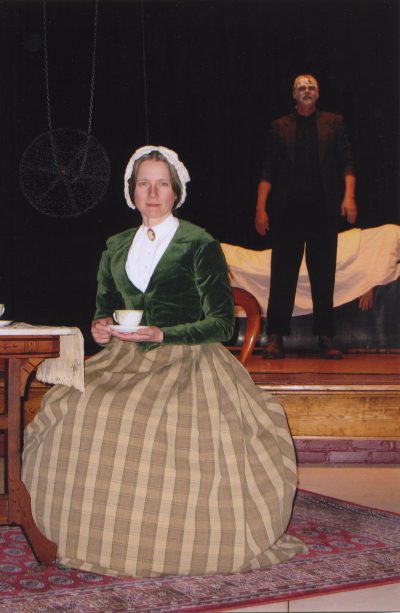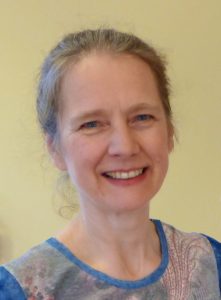
Event details
- Thursday | June 15, 2023
- 3:00 pm - 4:30 pm
- 151 S Church St, Spartanburg, SC 29306
- 864-596-3500
 ASL interpreted Show
ASL interpreted Show
Registration required. Click here to register.
FREE Admission. Seating is limited.
Mary Shelley, portrayed by Susan Marie Frontczak
Mary Shelley’s groundbreaking novel Frankenstein, poses the question: What if someone discovered the secret to creating life? It then explores the ramification of such a discovery: Are we capable of managing our technological creations? Furthermore, what responsibility (if any) do we hold in caring for abandoned or wronged members of society? Mary Shelley raises these questions from a context of living much of her life as an outsider – learning early on that her mother challenged societal norms and that she died as a result of Mary’s birth, at odds with a stepmother who brought two children of her own into the marriage with her father, rejected by her father upon her elopement with Percy Bysshe Shelley, shunned for life by her husband’s family, and betrayed by a close friend. In fact, the big reveal in learning about Mary Shelley is to discover how much the story of the fantastical, wretched, hideous creature brought to life in a Swiss laboratory draws on or parallels Mary’s experience in England as an intelligent daughter of two notable middle-class authors and the consort/wife of an aristocrat poet.
Shows Schedule
 Susan Marie Frontczak has given over 850 presentations as Marie Curie, Mary Shelley, Irene Castle, Clara Barton, Eleanor Roosevelt, and Erma Bombeck across 43 of the United States and abroad in her 21 years as a Living History scholar. She also works with both adults and youth to develop their own Chautauqua presentations. Susan Marie authored the Young Chautauqua coaching handbooks for Colorado Humanities and coaches students in grades 3 through 12. In 2022 she joined the faculty of the new Chautauqua Training Institute run through North Dakota Humanities that is coaching a dozen new Chautauqua scholars from across the country.
Susan Marie Frontczak has given over 850 presentations as Marie Curie, Mary Shelley, Irene Castle, Clara Barton, Eleanor Roosevelt, and Erma Bombeck across 43 of the United States and abroad in her 21 years as a Living History scholar. She also works with both adults and youth to develop their own Chautauqua presentations. Susan Marie authored the Young Chautauqua coaching handbooks for Colorado Humanities and coaches students in grades 3 through 12. In 2022 she joined the faculty of the new Chautauqua Training Institute run through North Dakota Humanities that is coaching a dozen new Chautauqua scholars from across the country.
For Susan Marie, Mary Shelley’s Frankenstein represents coming full circle. In her early life she delighted in the magical and supernatural world of fairy tales. This was supplanted for a number of years by a career in the sciences and engineering. Frankenstein brings her back to the imaginary, albeit transformed into the possible by today’s medical and technological advances and shadowed by the question mark of bioethical responsibility.
Secrets Revealed by Susan Marie Frontczak
Secrets not only pervade Mary Shelley’s seminal novel Frankenstein, but permeate her own life as well. While some might keep secrets for competitive advantage in business or war, Mary and her characters more often made close-mouthed choices in order to retain reputation (avoid shame or guilt) or to protect personal safety.
At the age of 16, Mary ran off to Europe with poet Percy Bysshe Shelley (PBS). They tried to escape without notice, but her stepsister tagged along for the adventure, and then her stepmother followed them to Calais to try to persuade them of their folly. They went anyway, though no longer under wraps.
Mary and PBS were expecting their first child when they departed in 1814. While they likely did not yet know she was expecting then, by the time they returned to England she had to live in hiding: She was no longer welcome at home, and no pregnant woman, married or otherwise, would dare go out in public once she began to show.
The stigma of illegitimacy could be avoided in by marrying prior to the birth of the baby, even if not prior to conception, so long as you kept quiet about it. Indeed, Mary’s parents, William Godwin and Mary Wollstonecraft, wed five months before Mary was born. That option wasn’t available to Mary seventeen years later, because PBS was already married to someone else (who also had a bun in the oven by him).
Pregnancy out of wedlock was not uncommon in the 19th century. For the rest of her life Mary was sensitive to the predicament of women in compromising circumstances and assisted when she could. When one young unwed mother, Isabelle, was in despair at the prospect of having to give up her unplanned daughter, Mary conspired to obtain false papers to help Isabelle and a fabricated “husband” – a woman who disguised herself for the rest of her life as a Mr. Douglas, escape to France to raise her daughter there.
In Frankenstein the title character Victor Frankenstein resorts to much more extreme efforts at concealment with respect to his progeny, born of the laboratory. For months Victor sequesters himself, neglecting rest and nourishment, to discover and reveal the “principle of life.” His ego spurs him on. “I was surprised, that among so many men of genius who had directed their enquiries towards the same science, I alone should be reserved to discover so astonishing a secret.”
But once his Creature comes to life, shame and remorse seize Victor. He tells no one what he has made. The Creature, at first lost and afraid, has to learn to shift for himself. In his abandonment, the Creature eventually becomes violent. Victor is so paralyzed with regret that he cannot bring himself to admit in public what he has brought into being, even though with his knowledge a young woman is sent to the gallows for a murder he knows the Creature committed. At one point Victor promises to tell his fiancée a dreadful secret once they are wed, but he never gets the chance to follow through on this vow. His refusal to own, parent, or nurture his creation leads to his demise, even as he attempts to destroy the being he brought to life.
Frankenstein can be viewed as a cautionary tale, saying that humans don’t know what they are getting into when they mess with God’s creation through their technological developments. Frankenstein’s subtitle, The Modern Prometheus, alludes to how angry the gods were when Prometheus stole fire and gave it to man, because man just doesn’t have the wisdom to manage fire. Yet at the same time, Mary includes compelling arguments for why Victor is justified in his attempts to undo his own handiwork.
Frankenstein is constructed as a story within a story within a story, each layer revealing new unknowns. The outermost layer – the beginning and end of the book – consists of letters from a sea captain to his sister. Captain Walton’s ambition is to discover the secret to a northwest passage to the Orient. Like Victor, he envisions reaping glory for conquering the unknown. Within that narrative layer we meet Victor Frankenstein, who then tells his story. But in the center of the book, within Victor’s story, we hear from the Creature, telling us the story from his point of view.
Abandoned by his creator, the Creature wanders into the world only to meet repeated rejection and abuse. Eventually he sequesters himself in a lean-to next to a cabin for his own safety. Observing the family in the adjacent cabin permits him to learn speech and literacy. In time, out of a profound loneliness and in quest of human companionship, he risks exposing his secret existence to the old blind man in the cabin, who cannot reject him for his hideous appearance. Tragically the Creature’s daring is exposed and leads to loss of the only “family” he has ever known. With his safe haven gone, he turns to revenge.
While some want to unveil secrets for personal glory or to achieve an end, in her personal life Mary strove to uncover truth. When she found out that a longtime friend besmirched her character behind her back through false rumors, Mary managed to meet the perpetrator head on and mend the relationship. In Frankenstein she exposes truth of human nature through the back door, giving us the chance to decide whether we think Victor Frankenstein’s accomplishments and choices make him the hero or the villain. In her diary Mary quotes her (then deceased) husband Shelley saying, “The curse of this life is, that what we have once known, we cannot cease to know.” Is it even possible for humanity to walk back from something it has invented? How do we humans want to comport ourselves if and when we find that something we have released upon the world – or allowed to be released – has turned into a monster?
1792 – Mary’s mother Mary Wollstonecraft publishes “Vindication of the Rights of Woman.”
1793 – Mary’s father William Godwin publishes “Political Justice.”
August 30, 1797 – Mary Godwin born to William Godwin and Mary Wollstonecraft Godwin. Her mother dies 11 days later.
Dec 21, 1801 – William Godwin remarries. Mary now has an older half sister, a stepsister and stepbrother. From this marriage she later gains a half brother.
July 28, 1814 – Mary Godwin and Percy Bysshe Shelley run away to the Continent for six weeks.
Summer of 1816 – Mary begins to write Frankenstein.
Dec. 15, 1816 – Percy Bysshe Shelley’s wife Harriet dies.
Dec. 30, 1816 – Mary and Percy Bysshe Shelley marry.
Jan. 1, 1818 – Frankenstein published
Jul. 8, 1822 – Percy Bysshe Shelley drowns. One of five children from their union survives to adulthood, Percy Florence Shelley.
1820-1844 – Mary writes and publishes five other novels; numerous short stories; biographies of Eminent Literary and Scientific Men of Italy, Spain, Portugal, and France; and Rambles in Germany and Italy.
February 1, 1851 – Mary dies of a brain tumor.
Quotes from Frankenstein by Mary Shelley
“The world to me was a secret which I desired to divine.” [1818 Edition]
“The world to me was a secret which I desired to discover.” [1831 Edition]
“Whence, I often asked myself, did the principle of life proceed? … I was surprised, that among so many men of genius who had directed their enquiries towards the same science, I alone should be reserved to discover so astonishing a secret.”
“I see by your eagerness, and the wonder and hope which your eyes express, my friend, that you expect to be informed of the secret with which I am acquainted; that cannot be: listen patiently until the end of my story, and you will easily perceive why I am reserved upon that subject, I will not lead you on, unguarded and ardent as I then was, to your destruction and infallible misery. Learn from me, if not by my precepts, at least by my example, how dangerous is the acquirement of knowledge, and how much happier that man is who believes his native town to be the world, than he who aspires to become greater than his nature will allow.”
Quotes by Mary Shelley
“[S]upremely frightful would be the effect of any human endeavor to mock the stupendous mechanism of the Creator of the world.” Introduction to Frankenstein 1831 edition
[When a secret is revealed] “The curse of this life is that what we have once known, we cannot cease to know.” from Mary’s diary, paraphrasing from her husband.
“Of what a strange nature is knowledge! It clings to the mind, when it has once seized on it, like a lichen on the rock.” Spoken by the Creature in Frankenstein
“I am tempted to offer to write a brief outline of Mr [sic] Shelleys [sic] life if Galignani chose – but then my secret must be kept religiously – & no alterations [sic] made – it would {be} very short & its chief merit the absence of incorrectness…” Mary Shelley to Cyrus Redding ?3 September 1829.
Quote about Mary Shelley
“As you expressed a desire to know my opinion of Mrs. Shelley, I will take the present opportunity of saying, that I rarely, if ever, met with a woman to whom I felt so disposed to apply the epithet “bewitching.” I can of course merely speak of appearances, but she struck me in the light of a matured child; a union of buoyancy and depth… Her hilarity, contrasted with the almost sadly profound nature of some of her remarks, somewhat puzzled me… I doubt her being a happy woman, and I also doubt her being one that could be distinctly termed melancholy… She reminded me of no person I ever saw but she has made me wish the arrival of the time when I am to see her again.”
Letter from Maria Jane Jewsbury to Anna Jameson dated 18 June 1830
Frankenstein
Shelley, Mary. Frankenstein. <There are numerous in-print and e-book editions, with or without commentary. Most likely these are the 1831 version rather than the 1818 version. I have no strong reason to recommend one publisher or edition over another. Give yourself a break getting used to the language. The first few chapters/letters may feel like slogging through molasses both because the language is 200 years old and because we are reading about a sea captain instead of a scientist in the laboratory. Breeze past and keep reading, until you get to the Creature’s story.>*
Biographies of Mary Shelley
Bennett, Betty. Mary Wollstonecraft Shelley, An Introduction. Johns Hopkins University Press, Pickering and Chatto, 1996. This book is easy to read and gives excellent insights into the humanistic bent of Mary Shelley’s work across all her books.
Seymour, Miranda. Mary Shelley. Grove Press, 2000. If you really want to dive into Mary’s life, before and beyond Frankenstein this is the book for you.*
Books about the Era
Hay, Daisy. Young Romantics: The Shelleys, Byron, and Other Tangled Lives. Macmillan, 2011. This book gives a rich, intimate, personal perspective of the social political context in which Mary and her circle lived. I particularly appreciate how it make clear the tenuous position of women.
Adaptations of Frankenstein for Young Readers
Shelley, Mary, adapted by Larry Weinberg. Frankenstein. Random House, 1982. Suitable to elementary school students or reading level grades 3 to 4.
Shelley, Mary, adapted by Malvina G. Vogel. Frankenstein. Playmore, Inc., Publishers and Waldman Publishing Corp., New York, NY. Illustrated Classics Editions. copyright 2002. Suitable to upper elementary school students or reading level grade 5.
Shelley, Mary, adapted by Margrete Lamond. Frankenstein. Harper Collins, 2005. Suitable to middle school students or reading level grades 6 to 8.
*Available in Greenville County Library system
